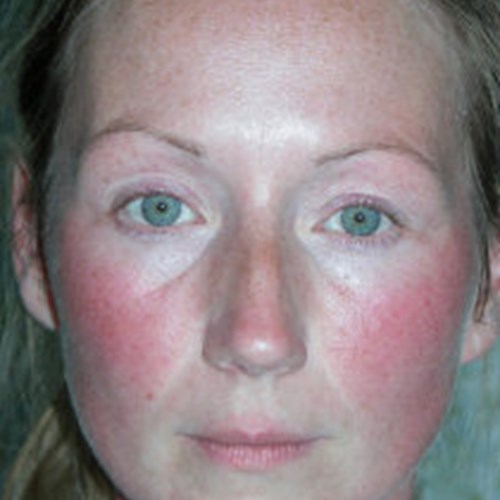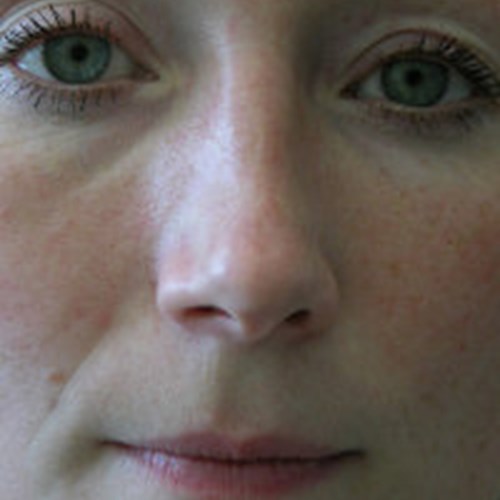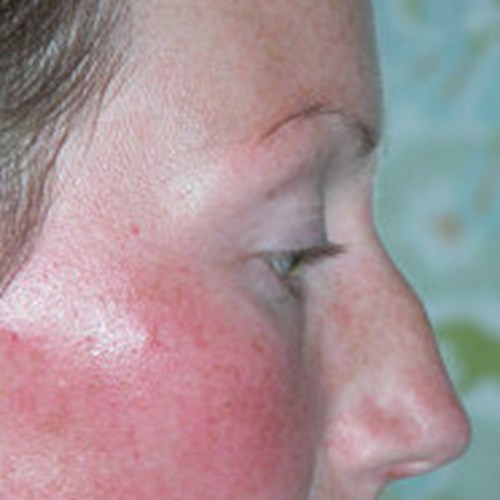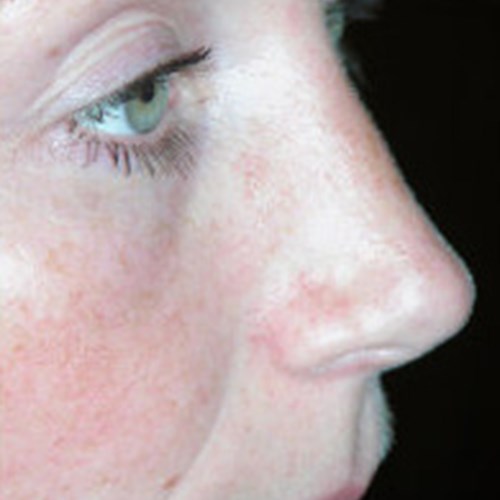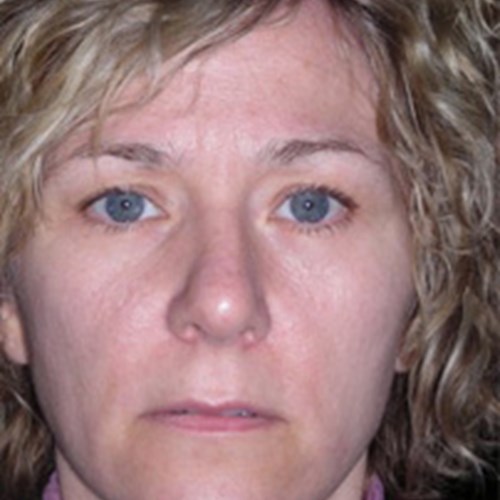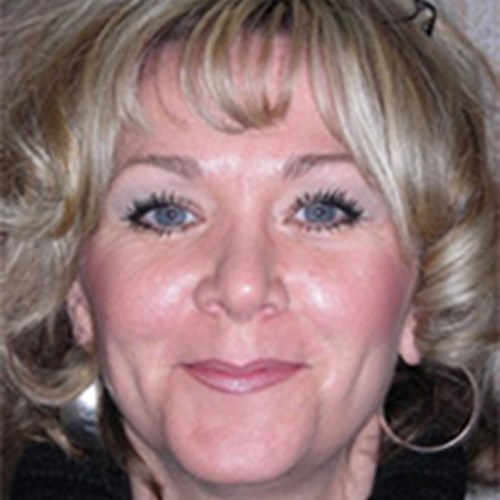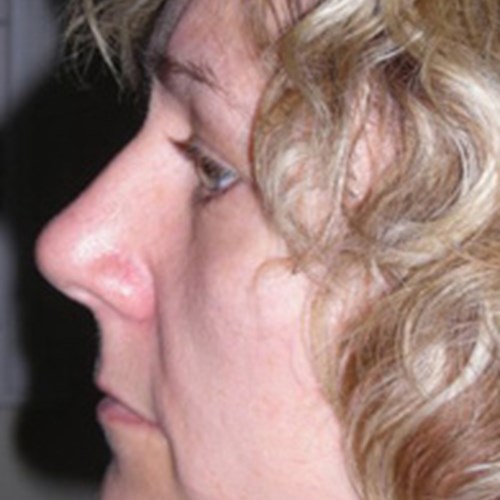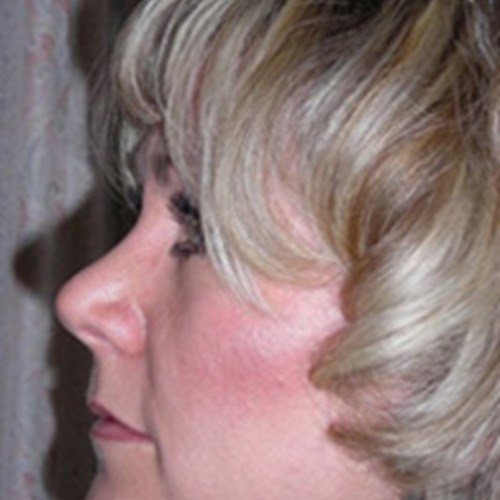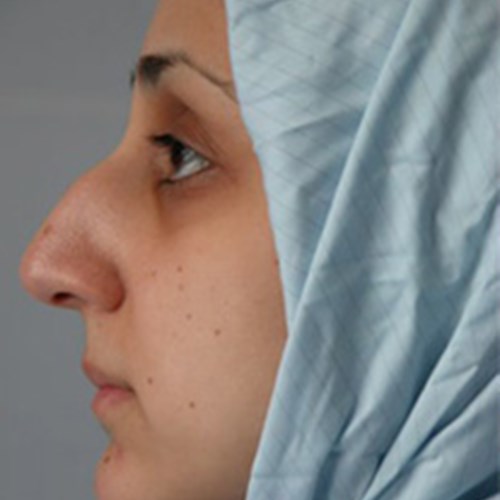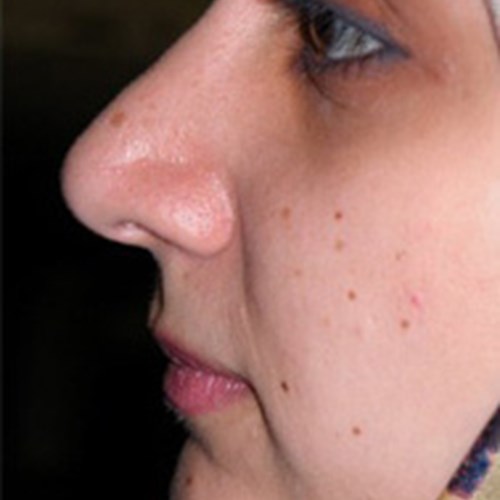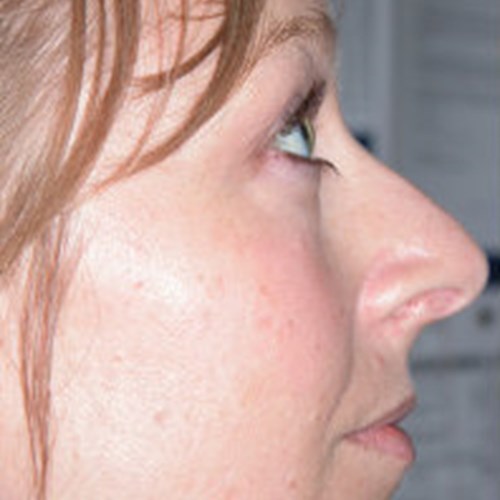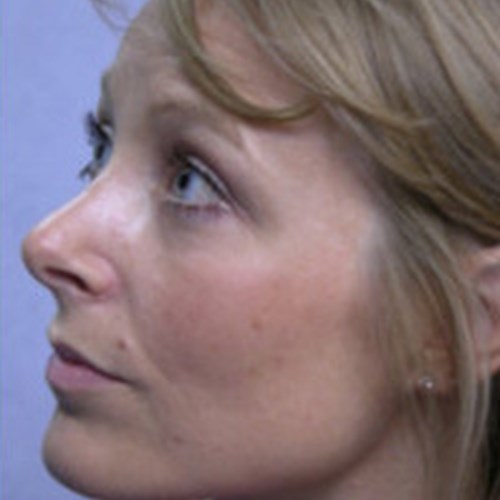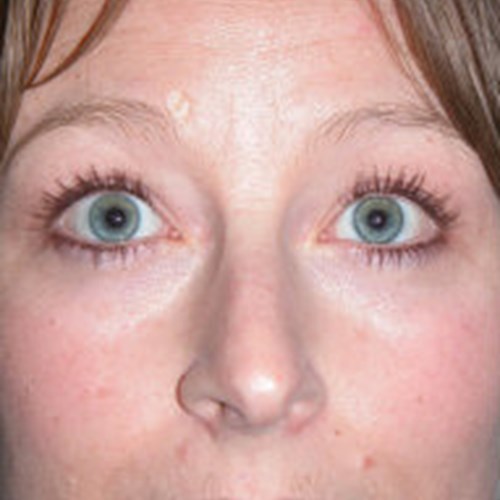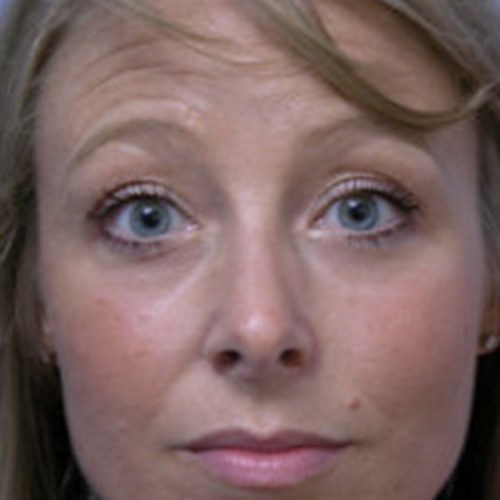Rhinoplasty is a commonly performed procedure. The nose is the central feature of the face and many people are self-conscious of the size or shape of the nose. The nose may be seen as too big, too small or have some other features that they dislike. Once the nose stops growing - at about 16 years old in females and about a year or two later in males - surgery can be performed to alter nasal shape.
Rhinoplasty usually involves altering the shape and size of the skeleton of the nose and allowing the skin to follow of its own accord and in its own time. Although some change in the shape of the nose will be noted following surgery, because the skin has to adapt to the skeleton of the nose, and because it takes time for swelling to subside, the final shape may only be achieved after 18 months or more.
The upper 40% of the nasal skeleton consists of bone, the lower 60% of more malleable cartilage. Rhinoplasty may involve surgery to one or both elements. Either may be reduced, added to or reshaped. Frequently the nose is made smaller - the bony bridge and the cartilaginous tip are reduced. The bones may be brought closer together or adjusted in some other way. The tip may be lifted or refined. Nostril size and shape can be altered to a degree, but this requires surgical excision of skin and leaves scars on each side of the nose. Patients with flat or Negroid noses may require elevation of the bridge by addition of tissue, usually bone, sometimes cartilage. Breathing problems can be addressed by adjusting the septum in the middle of the nose, or by other procedures.
Although rhinoplasty can have a high degree of patient satisfaction, secondary surgery can be required in about 10% of patients. Secondary surgery usually entails addition or adjustment of cartilage or bone. Rhinoplasty is thus a group of operations and each procedure is individualised according to the patient's unique requirements.
Facial harmony and beauty relies on a pleasing relationship between facial features. These features should be in proportion and to achieve an optimal result with rhinoplasty it might be necessary to perform simultaneous adjustment of either your chin or cheek.
Pre-operatively
It is important, to accurately define exactly what it is that bothers you about your nose. You may see your nose differently from the way your surgeon does. At the initial consultation, be specific about dissatisfaction with size and shape of the various parts of your nose, what bothers you and what does not and which features you would like altered. Try to make a list of priorities for yourself. For the rhinoplasty patient, other aspects of their medical history which are of importance are:
- Have you had any previous nasal problems, surgery or trauma?
- Do you suffer from hay fever or allergic rhinitis?
- Is your breathing normal through each nostril?
- Are you on any medication or do you have any known allergies?
At the initial examination your nose and face will be examined. This includes the inside of the nose to assess the septum. An operative plan will then be formulated. This will be derived from what you want and what is surgically possible. Surgery is not always able to change every feature and some things might be unattainable, for example, thick oily skin of the tip of the nose cannot be surgically altered. Older men, in particular, tend to have thicker skin and noses, which may remould poorly compared to those of other patients. It has become fashionable to demonstrate your new nose with computer generated and enhanced images. Bear in mind that what might be possible on the computer may be impossible to achieve with surgery. In addition, many other factors come to bear on final nasal shape and outcome – factors such as wound healing and skin contraction can be unpredictable and your new nose may bear no resemblance to a preoperatively generated computer image. Mr Soldin does not use computer generated images for these reasons – they can be used as a selling point and generate unrealistic expectations.
After the consultation you should have a clear idea of what can be achieved and what surgery will entail. It is important that your expectations are realistic and that you understand that all surgery has limitations and carries some degree of risk.
Other aspects to be discussed are venue for surgery, anaesthesia to be used, surgical techniques, risks, complications, costs and so on. In general, if I am to perform bony work, especially if the nasal bones need to be fractured and moved, because of the swelling associated with this, I prefer patients to be admitted to hospital for one night. Also, if nasal bone fractures are required, I prefer general anaesthesia, whereas for other kinds of rhinoplasty, sedation and local anaesthesia may be sufficient.
Medical aids and insurance companies do not pay for cosmetic surgery. If, however, the procedure is performed for reconstructive purposes, to correct a breathing problem or a marked deformity, the procedure may be covered. Check with your medical aid and obtain pre-authorisation for your surgery.
Surgery
No special preparation is required before surgery. You should be fit and healthy on the day of surgery and not suffering from any respiratory tract infection. Wash you face well on the morning of surgery. Prior to surgery, the anaesthetist will see you and discuss your medical history.
Rhinoplasty usually takes about one and a half to two hours, though complicated procedures may take longer and simpler procedures may be shorter. Rhinoplasty may be performed as a closed procedure through incisions inside the nose. For simple removal of a dorsal hump this approach is my preference. If tip work is needed I often make a small cut between the nostrils to open the nose (open approach). Better visualisation with an open approach allows me to be more accurate in shaping structures inside the nose, but leaves a scar under the nose. With time this incision should be barely visible.
Once the skin of the nose is lifted from its supporting framework of bone and cartilage, this framework is then sculpted to the desired shape. The nature of the sculpting will depend on your problem and a number of techniques may be used. Finally, the skin is redraped over the new framework, the wounds closed and a dressing applied. A splint and packs in the nostrils may be used.
Post-operatively
After surgery, particularly during the first twenty-four hours, your face will feel puffy, your eyelids will be swollen, your nose may ache, and you may have a dull headache. Although you may feel some discomfort, you should not experience much pain. Painkillers will be prescribed. Plan on staying at home with your head elevated for the first few days. Sleep with your head on 2 pillows too. Day cases will be discharged on the day of surgery, those patients who require bony surgery, or who choose, can stay in hospital for a night.
You will notice that the swelling and bruising around your eyes will increase at first, reaching a peak after two or three days. Applying cold compresses or ice packs will reduce this swelling and make you feel a bit better. Also, maintaining an elevated position such as sleeping on two or three pillows will allow the fluid to drain. Arnica, a homeopathic remedy, can be started on day 2 and will help swelling to subside. You may continue to feel some stuffiness for several weeks. Although swollen and bruised, you will feel a lot better than you look. Most of the swelling and bruising should disappear within three weeks or so. Some subtle swelling - unnoticeable to anyone but you and your surgeon - will persist for several months.
A little bleeding is common during the first few days following surgery. You can dab this away gently with gauze, a clean handkerchief or tissues. Do not blow your nose for a week or so following surgery. Try not to sneeze through your nose during this time. If you are going to sneeze, cough it out. Avoid excessive sniffing. The crusts on you nose can be very gently cleaned with warm water, and regular application of a nasal ointment that I usually prescribe.
If you have nasal packing, it will be removed the day following surgery, after which you will feel much more comfortable. After about one week the nasal splint will be removed.
Any surgery may make you feel lousy and for the first few weeks following the rhinoplasty operation your mood may be down, you may feel depressed and even tearful. This is normal and as your body heals and the swelling and bruising subside, so your mood will improve.
Most rhinoplasty patients are up and about within a few days. Although you will be able to return to work, you will look bruised and swollen and your nose may be blocked. It will be several weeks, however, before you are entirely up to speed and you will probably feel more comfortable if you take two weeks off work.
Avoid strenuous activity (jogging, swimming, bending, and sexual activity - any activity that increases your blood pressure) for four weeks. Avoid hitting or rubbing your nose (contact sports), or getting it sunburned, for eight weeks. Be gentle when washing your face and hair or using cosmetics. You can wear contact lenses as soon as you feel like it and as soon as the eyelid swelling has subsided enough so that you can put them in without difficulty.
Risks
When rhinoplasty is performed by a qualified plastic surgeon, complications are infrequent and usually minor. Nevertheless, there is always the possibility of complications, including infection, nosebleed, or a reaction to the anaesthesia.
When bony work is required (osteotomies, or nasal bone fracture), considerable swelling and bruising of the face, eyelids and nose can occur for a number of weeks after the operation.
If an open technique is used an incision is made between the nostrils which leaves a scar. This is usually inconspicuous although poor scarring can rarely occur. If the poor scarring is within the nose, alterations in air flow may result – thus in uncommon situations the nasal shape may be improved, but the function may be worse.
Numbness of the nasal tip is normal following surgery and this may take about 3 months to improve. Infection, bleeding, asymmetries, feeling or even seeing the edge of the broken nasal bone are all possible.
On occasion, a second procedure may be required to correct a minor deformity. Such cases are unpredictable and happen even to patients of the most skilled surgeons. The corrective surgery is usually minor, but may involve additional expense. Like most surgeons, I prefer to wait one year before carrying out any revisional surgery.
On rare occasions the bone joining the upper internal nose and the lower brain can be damaged – if this happens loss of smell may occur, and CSF (cerebro-spinal fluid) can leak out. This can also result in meningitis ( infection of the covering of the brain ) and be serious.
Your new look
In the days following surgery, when your face is bruised and swollen, it is easy to forget that you will be looking better soon. Healing is a slow and gradual process. Some subtle swelling may be present for months, especially in the nasal tip. The final results of rhinoplasty may not be apparent for a year or more.
It is worth anticipating your own reaction to the first sight of yourself and your new nose. To start with, you will look rather strange in the mirror and not quite 'you'. It takes a few days for your mind's eye to adjust itself to your new appearance and to recognise it as 'you'. Your look will also change as swelling and bruising subside and as the skin shrinks down on to the altered nasal skeleton. Slowly, over time, you will settle in to your new nose.
Family and friends may not even notice you have had surgery and you should not be surprised by their lack of reaction to you. They have not been as conscious about your nose as you have been. It is recommended that if you have any anxieties about family and friends noticing a change in your appearance, change your hairstyle at the same time to act as a distraction.
Your new nasal shape, once you have settled into it, will be permanent. If your goals are realistic and if your expectations of surgery are accurate, your new nose should present a more harmonious relationship with the rest of your facial features and you should be happy.
Are the results permanent?
The expected improvement with nasal surgery can be dramatic –The nose is the centre of the face and plays an important part in how you see your self, and how others see you. This improved appearance may lead to better life quality, better relationship and job prospects, and other benefits. It is important however to remember that this improvement is not only because of the nasal shape alteration – it accompanies the improved self esteem and better mental attitude that you may have as a result of the nasal shape alteration. Surgery however cannot stop the ageing process – with a balanced diet, healthy lifestyle, and sun protection the results should last well over 10 years.
If you are worried post-operatively
Telephone the ward of the hospital from which you have been discharged.
Telephone my secretary Angie Harrison during office hours – 07961221874
In an emergency (and you have failed to contact me by the above two methods) then please telephone St George’s Hospital (020 8672 1255) and ask them to either bleep me or the Resident Plastic Surgery doctor on call (Bleep 7050).
